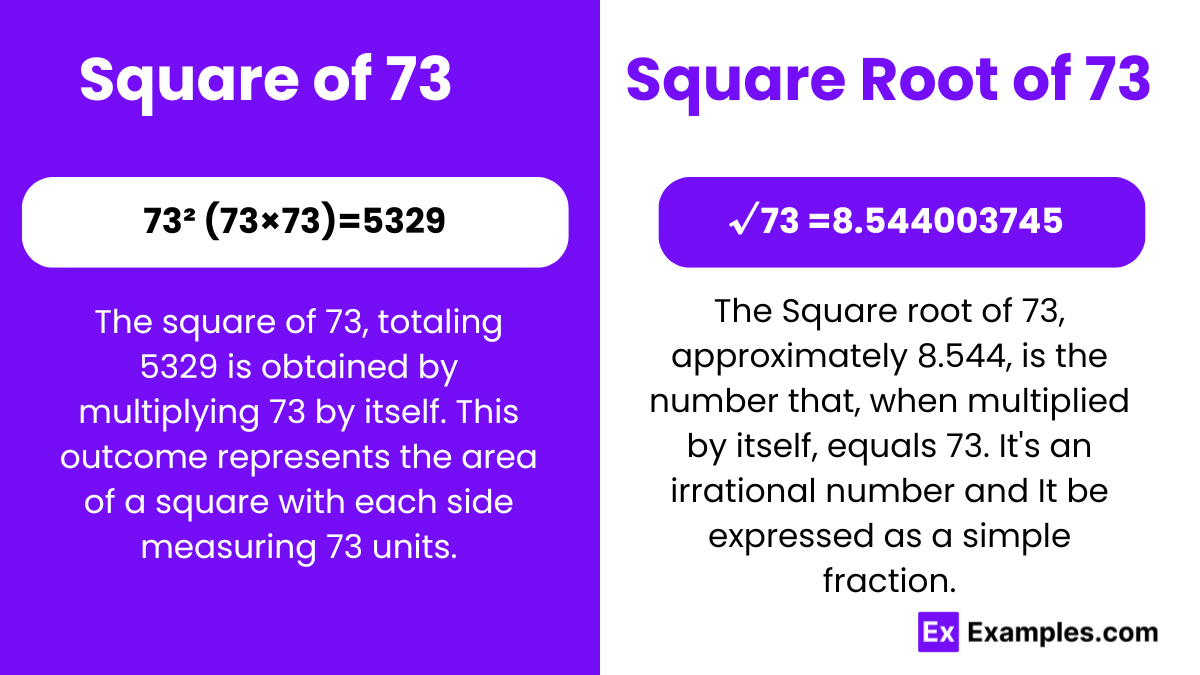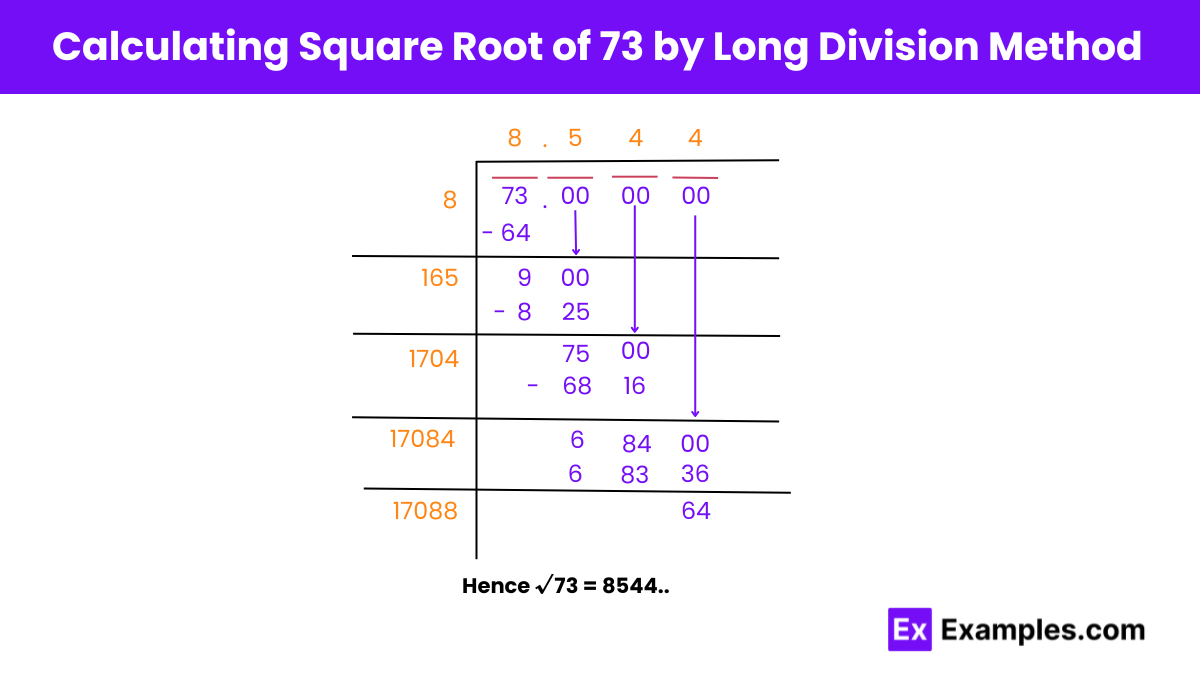What is the square of 73?
5329
5331
5333
5335


A square number results from multiplying an integer by itself. The square of 73 is 5329. In mathematics, square numbers exhibit distinct properties, crucial for understanding algebraic relationships and patterns. Exploring the square of 73 unveils fundamental principles, enriching comprehension of mathematical structures and operations.
The square root, a fundamental concept in mathematics, reveals the number that, when multiplied by itself, yields the original number. The square root of 73 is approximately 8.544. Understanding square roots elucidates the properties and relationships underlying numbers, offering insights into the square of 73 and its mathematical significance.
Irrational number means it cannot be expressed as a simple fraction (ratio of two integers) and its decimal representation is non-repeating and non-terminating.
A rational number is any number that can be expressed as a fraction, where the numerator and denominator are integers, and the denominator is not zero.
Estimation Method:
Approximate the square root of 73 by finding the perfect squares closest to it, which are 64 (8²) and 81 (9²).
Since 73 lies between 64 and 81, the square root of 73 is approximately between 8 and 9.
Using a Calculator:
Babylonian Method (Iterative):
Start with an initial guess, say (x₀ = 8).
Use the iteration formula (xₙ₊₁ =1/2( xₙ + 73/xₙ).
Iterate until the result converges to a desired level of accuracy.
Prime Factorization Method:
Factorize 73 into its prime factors.
Group the factors into pairs and take one factor from each pair outside the square root.
This method is less practical for non-perfect square numbers like 73.

Step 1: We pair digits of a given number starting with a digit at one’s place. Put a horizontal bar to indicate pairing.
Step 2: Now we find a number which on multiplication with itself gives a product less than or equal to 73. As we know 8 × 8 = 64 < 73. Hence, their difference gives 9 and the quotient is 8.
Step 3:Now, we have to bring down 00 and multiply the quotient by 2. This give us 16. Hence, 16 is the starting digit of the new divisor.
Step 4: 5 is placed at one’s place of new divisor because when 165 is multiplied by 5 we get 825. The obtained answer now is 75 and we bring down 00.
Step 5: The quotient now becomes 85 and it is multiplied by 2. This gives 170, which then would become the starting digit of the new divisor.
Step 6: 4 is placed at one’s place of new divisor because on multiplying 1704 by 4 we get 6816. The new divisor now becomes 684 and we bring 00 down.
Step 7: Now the quotient is 854. When multiplied by 2, it gives 1708, which will be the starting digit of the new divisor.
Step 8: 4 is placed at one’s place of the divisor because on multiplying 17084 by 4 we will get 68336. So, now the divisor is 64.
A perfect square is the square of an integer, and since there is no integer n such that n×n=73, 73 is not a perfect square.
The number closest to the square root of 73 is 8. This is because the square root of 73 is approximately 8.544, and 8 is the nearest whole number to this value.
No, 73 cannot be expressed as the square of an integer, making it a non-perfect square.
The square root of 73 cannot be simplified further because it is an irrational number.
The decimal approximation of the square root of 73 is approximately 8.544.
No, the square root of 73 is not a prime number because it is not an integer. The square root of 73 is an irrational number approximately equal to 8.544.
Text prompt
Add Tone
10 Examples of Public speaking
20 Examples of Gas lighting
What is the square of 73?
5329
5331
5333
5335
Which of the following is closest to the square root of 73?
8.5
8.6
8.7
8.8
If x² = 73, what is the approximate value of x?
8.3
8.4
8.5
8.6
Simplify √73 to its decimal form.
8.47
8.48
8.49
8.50
What is the result of squaring 73?
5328
5329
5330
5331
Find the approximate value of √73 rounded to one decimal place.
8.4
8.5
8.6
8.7
Which number is closest to 73 but not a perfect square?
72
74
76
78
What is the value of √73 raised to the power of 2?
72
73
74
75
Determine the approximate square root of 73.
8.4
8.5
8.6
8.7
If x = √73, what is x² + 1?
74
75
76
78
Before you leave, take our quick quiz to enhance your learning!

